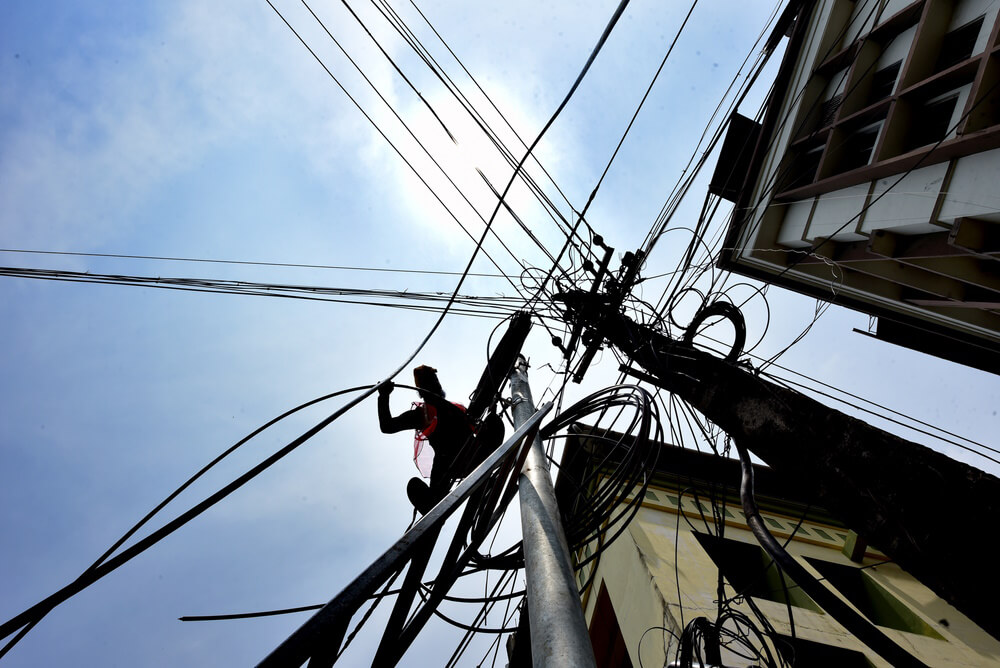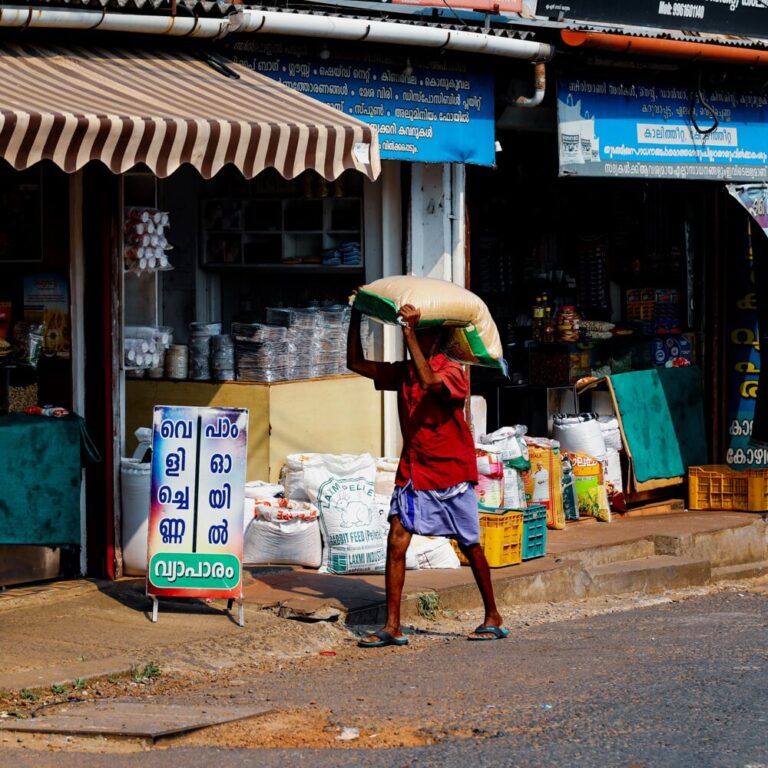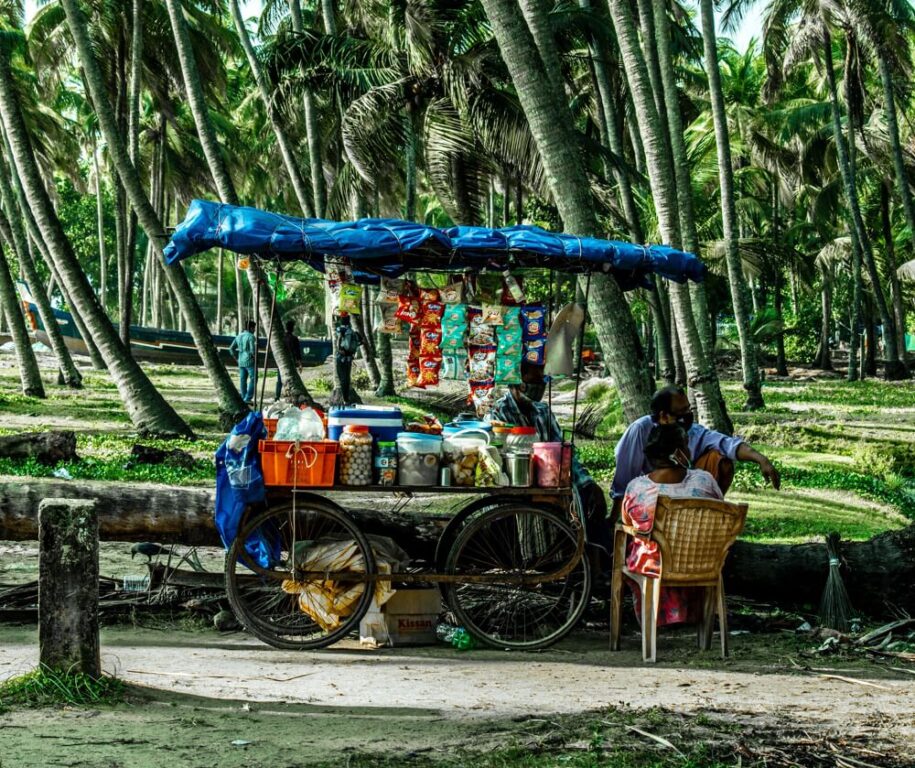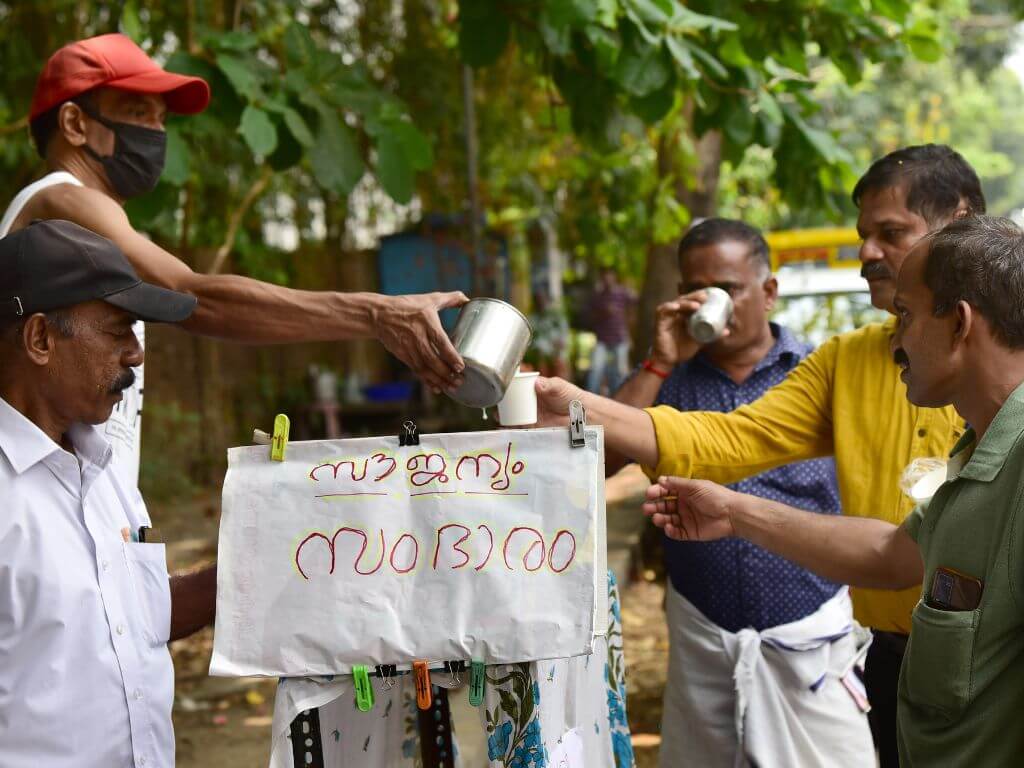People gathered around the thanneerpanthal, water kiosk in Malayalam, in Kasaragod (in the picture above), around 555 kilometres from Kerala’s capital city, Thiruvananthapuram, when it was inaugurated on March 15. It is one of the thousands of such kiosks across the state in which clay pots and jars with drinking water are placed to offer respite to people during the high maximum temperatures. The government’s initiative to offer sambharam as a coolant to beat the heat is an addition to the thanneerpanthals. The sambharam, buttermilk seasoned with cuts of ginger and onion, a few curry leaves and coriander leaves, is a popular heat regulator here.
In early March itself, the maximum temperature had touched 41.3 degrees Celsius at Kannur airport, which was the highest in the state for that time of the year. Panathur in Kasaragod, besides other places, sizzled with temperatures above 40 degrees Celsius. In mid-March, people in Thiruvananthapuram sweltered when the heat index crossed 54 degrees Celsius posing health risks especially to vulnerable populations. The heat index is calculated by factoring in humidity to the measured air temperature and is about how hot it “feels” to people.
Its effects on health can be damaging. “The health effects of heat are often described better by a combination of temperature and humidity, such as a heat index or wet bulb temperature…Excessive heat can have a devastating impact on human health, resulting in heat cramps, exhaustion, and life-threatening heat strokes. Children, the elderly, homeless and outdoor workers are most vulnerable. Excessive heat can also aggravate pre-existing pulmonary conditions, cardiac conditions, kidney disorders and psychiatric illness,” observed this paper.[1]
Faced with the heat wave, the government announced that the non-functional thanneerpanthals would be made functional. The thanneerpanthals, set up over the years from 2016-17, now number in thousands and offer some respite. As cities record high maximum temperatures, this and other measures listed in the state’s Heat Action Plan (HAP) have become important.
Drafted and published by the Kerala State Disaster Management Authority (KSDMA), the HAP specifies the responsibilities of each department for heat mitigation. Those working outdoors in the hot sun have to be given time off work from 11 am to 3 pm and a place to rest; the duty hours of traffic policemen are rescheduled or traffic wardens asked to assist them; schools have to avoid assemblies in the sun, and the water bell scheme – when a bell rings thrice a day as a reminder for students to drink water to prevent dehydration; cool roofs with alternative materials and green roofs are being promoted.
The Mazhappolima scheme for open well recharging through roof rainwater harvesting is promoted too. Also, the fire and rescue department has been sanctioned Rs10 crore to buy equipment, and fire audits are being done in vulnerable areas. While these are just a few of the initiatives under the comprehensive HAP, various departments including the local self-government, forests, health, and agriculture department among others, are conducting extensive awareness campaigns for sensitising the public on heat-related problems. Would these and other measures listed in the HAP be sufficient to address the increase in summer heat across Kerala?

Photo: Team QoC
Warming trend
Even as the March heat index hit headlines, experts say a rise in temperature during the summer months of February and March is not unusual in Kerala. The India Meteorological Department (IMD) data shows that the maximum temperatures for March, April and May are normal or near normal. “We issue alerts and warnings when the temperature rises 4 to 5 degrees Celsius above normal. This year, we have not issued any warnings,” said K Santhosh, director of IMD.
According to the Institute of Climate Change Studies (ICCS), the year 2022 was the sixth warmest year on record since 1901, along with 1987. The warmest year was 2016 followed by 2019. The annual mean temperature of Kerala was also higher in the recent decades. Dr Sivananda Pai, ICCS director, said, “We have observed a warming trend in Kerala, but the average temperature and the observed warming trends are in line with the observed warming in global mean surface temperature.”
Punalur and Palakkad have always been the hottest during summer. “That is because the dry winds from Tamil Nadu blow into the state mainly through the Palakkad and Punalur gaps, causing a rise temperature,” explained IMD director Santhosh.
Pathanamthitta, Wayanad, Kollam, and Kochi received summer rains on different days from March 15, bringing down the temperatures significantly. On March 19, the maximum temperature in Kochi was 32.8 degrees Celsius, Alappuzha and Kottayam were as hot as Punalur at 37 degrees Celsius, Thiruvananthapuram was 34.6 degrees Celsius; Kannur recorded a maximum temperature of 35 degrees Celsius and Kozhikode was at 36 degrees Celsius.
While there is no doubt that this summer is also one of the harshest with temperatures going up by 1 to 1.5 degree Celsius – even 2 degrees Celsius in some parts of the state – scientists assert there is no cause for alarm. Kerala has already seen summer showers but a high heat index can be uncomfortable, even hazardous to people’s health and productivity.
How is heat index calculated
The KSDMA’s list of temperatures soaring above 50 degrees Celsius was based on the heat index instead of actual temperatures. Heat index factors in humidity along with air temperature and is more about how hot it feels or the apparent temperature which causes discomfort. This year, the disaster management authority published the heat index for the first time. “We had tried to calculate the heat index a few years ago, maybe in 2016, when the temperature had soared. But we only had a few weather stations then and information was sporadic. Now, we have at least 80 functional weather stations and more accurate data,” said Sekhar Kuriakose, KSDMA member secretary.
The heat index formula is long but easy because it has a series of coefficients attached to either temperature or humidity. The formula factors clothing cover and its resistance to transfer heat and moisture, surface area of the average human, how well the skin absorbs and radiates heat, sweating rate, core body temperature among others. The methods for calculating the heat index, however, are not always the same.
“The coefficients are set according to the western conditions and it cannot be ideally applied to Indian conditions,” said Abhilash S, associate professor at the Department of Atmospheric Sciences, Cochin University of Science and Technology. “With urbanisation, and cities retaining heat, there is of course a linear trend in warming. We have observed an increase of 1-1.5 degree Celsius and sometimes even 2 degrees Celsius, but that’s quite normal. However, when the sun is directly above, exposure to direct sunlight should be avoided,” he added.
However, very slight variations have been observed in studies that compared the heat in different areas of a city, or between the urban and the surrounding rural areas of one or more cities. “This could be due to a number of reasons,” said Dr S Pai. “Urbanisation is one. But changes in weather patterns, change in wind direction, an increase or decrease in humidity can also contribute,” he said.

Photo: Aby Zachariah/ Unsplash
Nature-led planning ignored
Cities in Kerala have seen depleting green cover, most of them lost to infrastructure projects. The dense built-up areas trap heat. RS Anupriya and TA Rubeena of the Geography Department of the University College, Thiruvananthapuram, have studied temperature variations in the city. “Drastic changes in land use pattern, loss of vegetation, conversion of agricultural and vacant areas into built-up areas, and increase in the number of vehicles have contributed to the increase in urban heat. We can see this in the IT park area of Kazhakkoottam, a suburb of Thiruvananthapuram, where the built-up area has been increasing over the years,” said Anupriya.
Before the technopark came up, Kazhakkoottam was sprawling acres of green space with hills full of trees and plants. The technopark came up at the cost of nature. Roads were built, hotels, apartments and restaurants came up around the IT park, all contributing to the rise in the built environment which, international studies have shown, impact heat by causing higher temperatures within it.
Large-scale conversion of natural land cover into urban built-up areas reduces vegetative cover and increases impervious layer. In an earlier study on urban/ rural cooling rates in Thiruvananthapuram by Shareekul Ansar et al, it was noted that there was a stark difference in the rate of cooling in the urban and rural areas of the city, and that the rate of cooling decreased in the rural areas as night advanced.[2]
High-heat absorption of building materials and their emissions potential, blockage of wind due to high-rises, impervious surfaces such as roads and paved surfaces are factors contributing to the increased heat in urban areas. “We are maintaining green spaces in Thiruvananthapuram. The green zone around the zoo prevents an urban heat island phenomenon,” explained Anupriya. While the urban heat increase was found to be around 1 to 1.5 degrees Celsius in her studies, there was a difference in the heat between Thiruvananthapuram and 17 panchayats surrounding it.
Urban heat islands are formed when a city sees rampant construction and massive loss of green cover. Bijeesh Kozhikkodan Veettil and Atilio Efrain Bica Grondona published a paper in Acta Geophysica on the formation of small-scale urban heat islands in three populated districts of Kerala — Ernakulam (Kochi), Thrissur and Kozhikode.
The authors blame the land-surface temperature increase on unplanned urbanisation and loss of vegetation. Vegetation cover, particularly near urban areas, was found to have decreased by 5.8 per cent, 10.4 per cent and 9.6 per cent in Ernakulam (Kochi), Thrissur and Kozhikode respectively. In the study period between 1991 and 2017, Thrissur and Kozhikode districts saw higher increase in land surface temperature and higher reduction in vegetation cover compared to the highly populated and urbanised Ernakulam district.[3]

Photo: Aboodi Vesakaran /Unsplash
Saving green spaces a priority
Cities are becoming more populated but not preserving green spaces, or worse, destroying the existing ones will intensify heat waves.
According to the UN-habitat World Cities Report in 2022, urban population is expected to touch 2.99 billion by 2035 and it is estimated that India’s urban population will touch 675 million by then. Hence, understanding the urban microclimate changes and designing scientific adaptation techniques is important for planned urban development.
“Maintaining green spaces in cities should be a priority. Increasing green spaces will improve micro-climate conditions and will lower the urban heat island effect,” said Anupriya. Helping Kochi with such interventions and strategies is the Cities4Forests initiative, managed by the World Resources Institute, an international coalition of 69 cities. Kochi is the first city in India to join the coalition.[4]
Identifying heat as a critical issue, the Kochi Municipal Corporation initiated a series of interventions with technical support from WRI India. As a first step, the Kawaki initiative was launched. The name Kawaki, formed from two Malayalam words, kavu (grove) and aki (make), translates to ‘make a grove’. The objective is to develop and conserve urban forests at vulnerable localities in the city with support from the local community.
After the high heat alert, isolated summer rains have given the much-needed relief to the Kochi residents, who were getting exhausted not only with the rising temperature but also from the drastic air pollution from a fire at Brahmapuram waste plant in the city’s suburbs. Not only has the rain lowered the level of particulate matter but has also brought down the temperature to the 20s, at least during the night.[5]
“Increasing urban heat is indeed a critical issue. The solution lies in town planning and landscape management,” says Sridhar Radhakrishnan, an environmentalist. “For example, when we plan to build a road, we should also plan for cycle tracks, two-wheeler paths and trees. A national highway with trees on either side and a green cover on the median will help bring down the temperature by about 4 to 5 degrees Celsius.”
These small measures, if done effectively and diligently, will go a long way in reducing heat. C Jayaraman, managing director of Equinoct, which aims to provide science-based solutions for multiple challenges of Climate Change, said that urban heat increase requires urgent attention. “This problem has not been addressed at all. I do not know if the data we have is reliable. We have not looked into it yet, but since warming is a global issue, we need to build up local resilience,” he says.
Unless the urgency to correct man-made errors in planning and designing cities is recognised, and the importance of collective awareness in addressing the issue, the temperatures will continue to rise.
Reema Abraham is a science journalist with over a decade’s experience in print media. Recipient of the national award for science communication, Government of India, and also the Green Journalist Award by the Government of Kerala, Reema is passionate about environmental issues.
Cover photo: Team QoC




